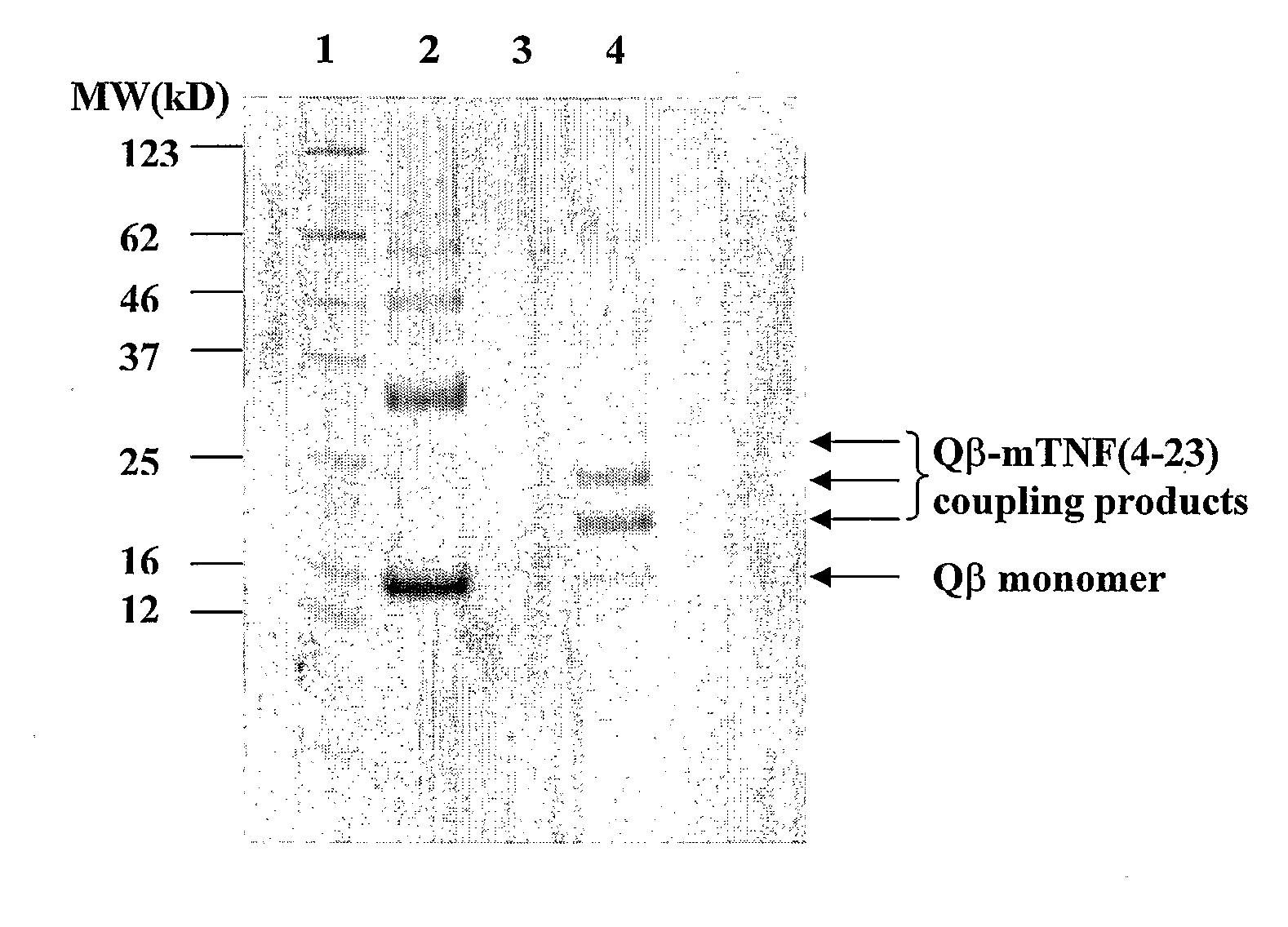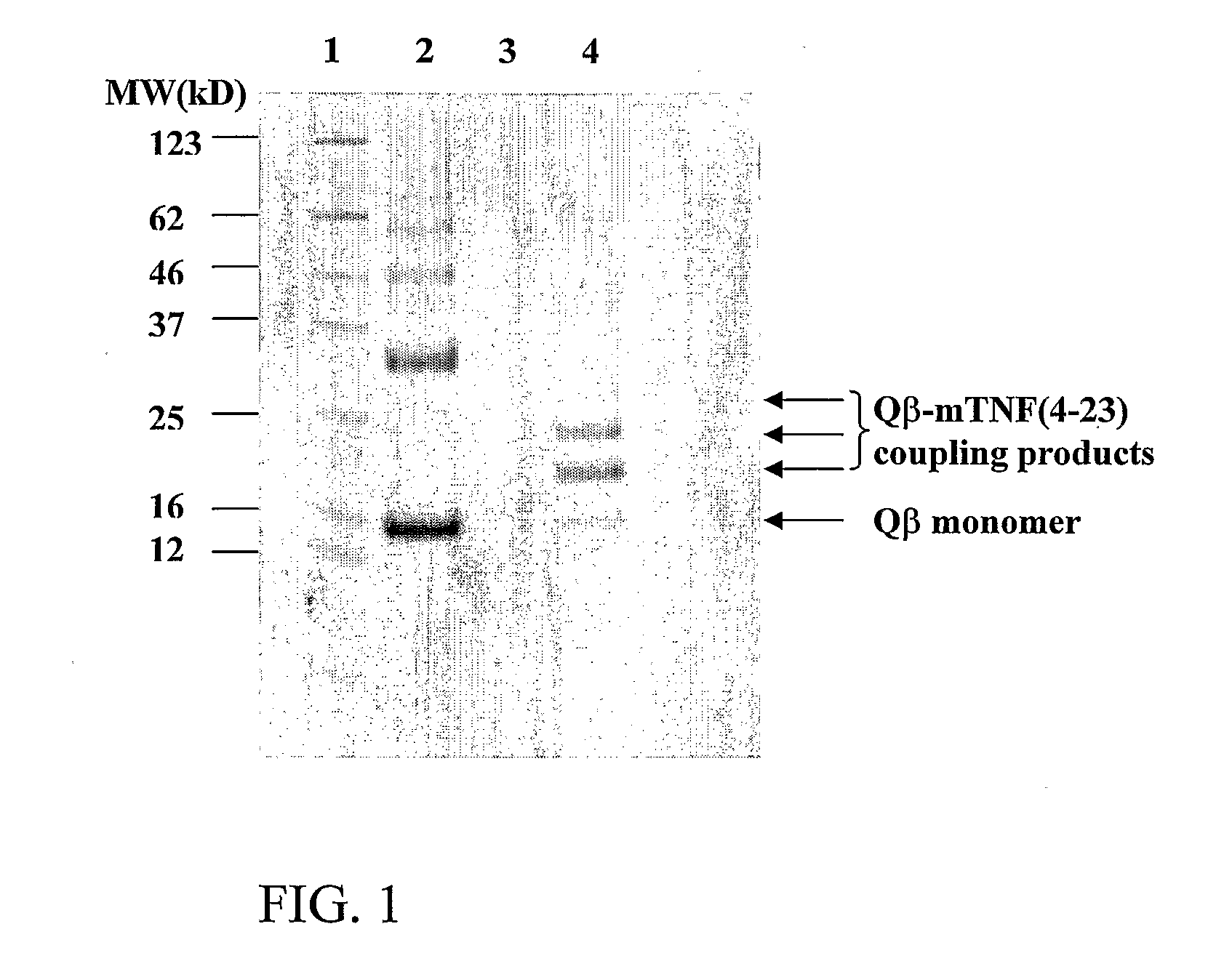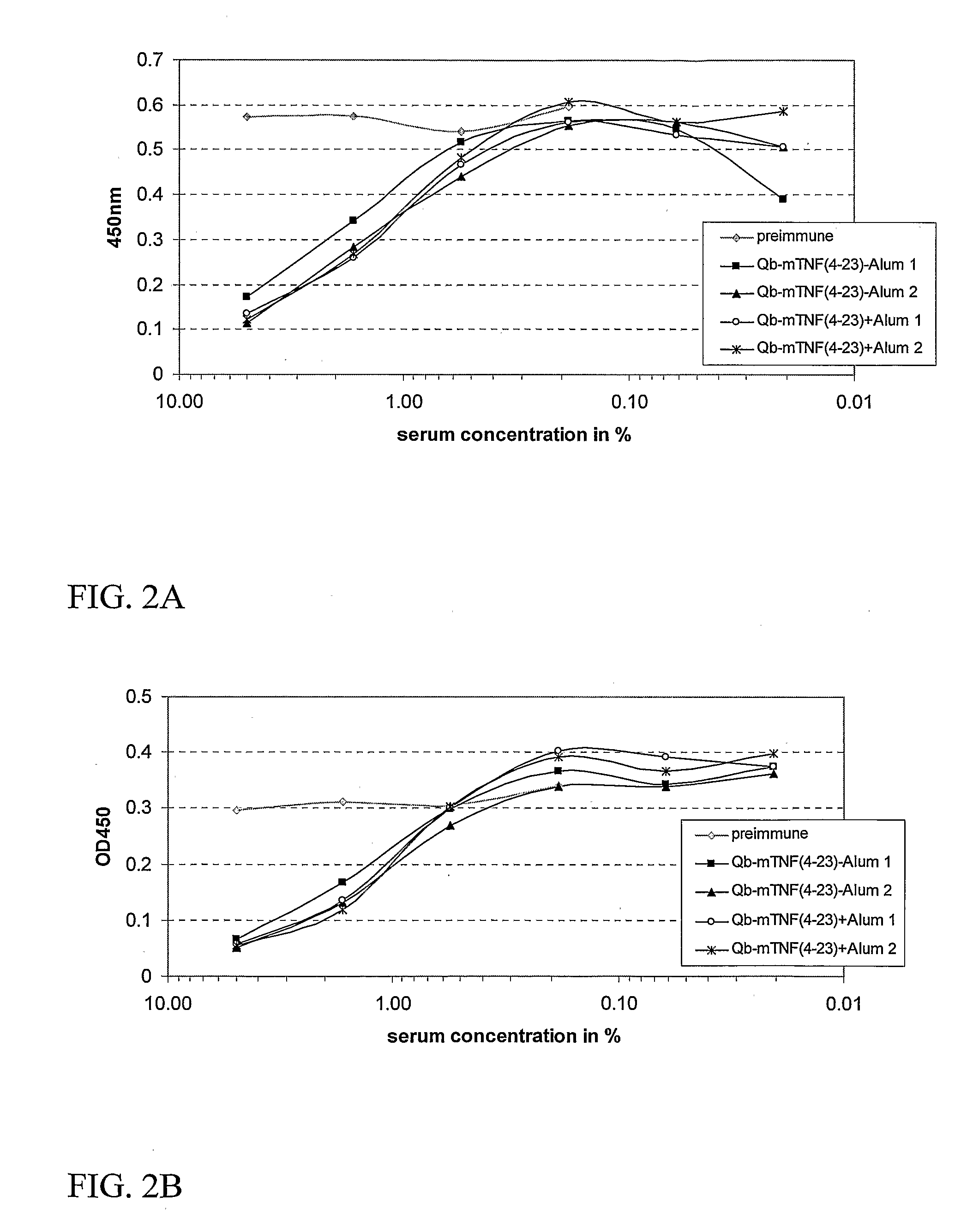Medical Uses of Carrier Conjugates of Non-Human Tnf -Peptides
a carrier conjugate and non-human technology, applied in the field of modified viruslike particles, can solve the problems of reducing affecting the absorption rate of antigens, and the immune system usually failing to produce antibodies against self-derived structures, etc., to achieve the effect of enhancing antigen absorption and increasing skin permeability
- Summary
- Abstract
- Description
- Claims
- Application Information
AI Technical Summary
Benefits of technology
Problems solved by technology
Method used
Image
Examples
example 1
[0283] A. Coupling of Murine TNFα(4-23) Peptide to Qβ Capsid Protein
[0284] A solution of 3 ml of 3.06 mg / ml Qβ capsid protein in 20 mM HEPES, 150 mM NaCl pH 7.2 was reacted for 60 minutes at room temperature with 99.2 μl of a SMPH solution (65 mM in DMSO). The reaction solution was dialysed at 4° C. against two 3 1 changes of 20 mM HEPES, 150 mM NaCl pH 7.2 for 4 hours and 14 hours, respectively. Sixty-nine μl of the derivatized and dialyzed Qβ solution was mixed with 265.5 μl 20 mM HEPES pH 7.2 and 7.5 μl of mTNFα(4-23) peptide with the second attachment site (SEQ ID NO:127 CGGSSQNSSDKPVAHVVANHQVE) (23.6 mg / ml in DMSO) and incubated for 2 hours at 15° C. for chemical crosslinking. Uncoupled peptide was removed by 2×2 h dialysis at 4° C. against PBS. Coupled products were analysed on a 12% SDS-polyacrylamide gel under reducing conditions. The Coomassie stained gel is shown in FIG. 1. Several bands of increased molecular weight with respect to the Qβ capsid monomer are visible, clea...
example 2
[0291] A. Coupling of Feline (i) TNFα(4-23) Peptide to Qβ Capsid Protein
[0292] A solution of 3 ml of 3.06 mg / ml Qβ capsid protein in 20 mM HEPES, 150 mM NaCl pH 7.2 was reacted for 60 minutes at room temperature with 25.2 μl of a SMPH solution (65 mM in DMSO). The reaction solution was dialysed at 4° C. against two 3 1 changes of 20 mM HEPES pH 7.2 for 4 hours and 14 hours, respectively. Thirty μl of the derivatized and dialyzed Qβ solution was mixed with 167.8 μl 20 mM HEPES pH 7.2 and 2.2 μl of fTNFα(4-23) peptide with the second attachment site (SEQ ID NO:128 CGGSSRTPSDKPVAHVVANPEAE) (23.6 mg / ml in DMSO) and incubated for 2 hours at 15° C. for chemical crosslinking. Uncoupled peptide was removed by 2×2 h dialysis at 4° C. against PBS.
[0293] B. Immunization of Mice with fTNFα(4-23) Peptide Coupled to Qβ Capsid Protein.
[0294] Six female balb / c mice were immunised with Qβ capsid protein coupled to the fTNFα(4-23) peptide. Twenty-five μg of total protein were diluted in PBS to 200...
example 3
[0299] A. Coupling of Mouse TNFα Protein to Qβ Capsid
[0300] A fusion protein consisting of an N-terminal, cysteine containing linker, a hexahistidine tag and the mature murine TNFα protein (corresponding to amino acids 78 to 233 of the immature protein) (SEQ ID NO:23) was recombinantly expressed in Escherichia coli and purified to homogeneity by affinity chromatography. A solution containing 1.4 mg / ml of this protein in 20 mM HEPES, 150 mM NaCl, pH 7.2 was incubated for 60 min at room temperature with an equimolar amount of TCEP for reduction of the N-terminal cysteine residue. A solution of 500 μl of 3.06 mg / ml Qβ capsid protein in 20 mM HEPES, 150 mM NaCl pH 7.2 was then reacted for 60 minutes at room temperature with 4.2 μl of a SMPH solution (65 mM in DMSO). The reaction solution was dialysed at 4° C. against two 3 1 changes of 20 mM HEPES pH 7.2 for 2 hours and 14 hours, respectively. Sixty μl of the derivatized and dialyzed Qβ solution was mixed with 30 μl H2O and 180 μl of t...
PUM
| Property | Measurement | Unit |
|---|---|---|
| diameter | aaaaa | aaaaa |
| pH | aaaaa | aaaaa |
| pH | aaaaa | aaaaa |
Abstract
Description
Claims
Application Information
 Login to View More
Login to View More - R&D
- Intellectual Property
- Life Sciences
- Materials
- Tech Scout
- Unparalleled Data Quality
- Higher Quality Content
- 60% Fewer Hallucinations
Browse by: Latest US Patents, China's latest patents, Technical Efficacy Thesaurus, Application Domain, Technology Topic, Popular Technical Reports.
© 2025 PatSnap. All rights reserved.Legal|Privacy policy|Modern Slavery Act Transparency Statement|Sitemap|About US| Contact US: help@patsnap.com



